Petunia
| Petunia | |
|---|---|
.jpg) | |
| Petunia exserta flower | |
| Scientific classification | |
| Kingdom: | Plantae |
| (unranked): | Angiosperms |
| (unranked): | Eudicots |
| (unranked): | Asterids |
| Order: | Solanales |
| Family: | Solanaceae |
| Subfamily: | Petunioideae |
| Genus: | Petunia |
| Species | |
|
See text. | |
Petunia is genus of 20 species[1] of flowering plants of South American origin. The popular flower of the same name derived its epithet from the French, which took the word petun, meaning "tobacco," from a Tupi–Guarani language. An annual, most of the varieties seen in gardens are hybrids (P. × atkinsiana, also known as P. × hybrida).
Symbolism and Folklore
The Mayan and Incas believed that petunias have the power to chase away (with their odor) the underworld monsters and spirits. Their flower-beds were bunched together for magical drinks. According to the folklore, Petunias will thrive where there is positive energy and will not grow in places where there is negativity.[2].
When given as a gift, Petunias typically have two meanings. They could represent being comfortable with someone, or "your company suits me"[3]. Conversely, they could also represent anger and resentment[4].
Taxonomy
Petunia is a genus in the family Solanaceae, subfamily Petunioideae. Well known members of Solanaceae in other subfamilies include tobacco (Nicotianoideae), and the cape gooseberry, tomato, potato, deadly nightshades and chili pepper (Solanoideae).[5] Some botanists place the plants of the genus Calibrachoa in the genus Petunia,[6] but this is not accepted by others.[7][8][9] Petchoa is a hybrid genus derived from crossing Calibrachoa and Petunia.[10]
Ecology
Petunias are generally insect pollinated, with the exception of P. exserta, which is a rare, red-flowered, hummingbird-pollinated species. Most petunias are diploid with 14 chromosomes and are interfertile with other petunia species.[11][12]
The tubular flowers are favoured by some Lepidoptera species, including the Hummingbird hawk moth.[13] The flowers are eaten by the larvae of the corn earworm, Helicoverpa zea and the cabbage looper, Trichoplusia ni.[14]
Cultivation
Petunias can tolerate relatively harsh conditions and hot climates. They need at least five hours of sunlight every day. They grow well in low humidity, moist soil. Young plants can be grown from seeds. Watering once a week should be sufficient in most regions. Hanging baskets and other containers need more frequent watering.[15] Maximum growth occurs in late spring. Applying fertilizer monthly or weekly, depending on the variety, will help the plant grow quickly. Petunias can be cultivated in hanging baskets.
In horticulture many terms are used to denote different types of cultivated petunias. These include Grandiflora, Multiflora, Wave (Spreading), Supertunia, Cascadia, and Surfinia.
Uses
Many species other than P. × atkinsiana are also gaining popularity in the home garden.[16] A wide range of flower colours, sizes, and plant architectures are available in both P. × atkinsiana and other species, listed below:[6]
Species
Species include:[17]
- P. alpicola
- P. axillaris
- P. bajeensis
- P. bonjardinensis
- P. exserta
- P. guarapuavensis
- P. inflata
- P. integrifolia
- P. interior
- P. ledifolia
- P. littoralis
- P. mantiqueirensis
- P. occidentalis
- P. patagonica
- P. reitzii
- P. riograndensis
- P. saxicola
- P. scheideana
- P. villadiana
Gallery
 Red Petunia in India,
Red Petunia in India, Petunia, Violet, In NIT Agartala, India
Petunia, Violet, In NIT Agartala, India Petunia, Violet, In NIT Agartala, India
Petunia, Violet, In NIT Agartala, India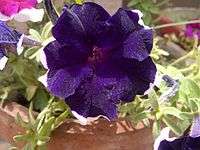 Petunia in india
Petunia in india Petunia in india
Petunia in india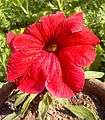
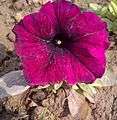 Petunia in india
Petunia in india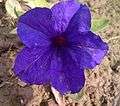 Petunia in india
Petunia in india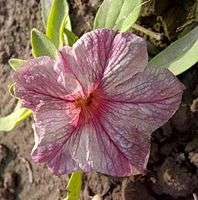 Petunia in india
Petunia in india- Flower pot planted with petunias
- A form of Petunia axillaris
- White Petunia axillaris
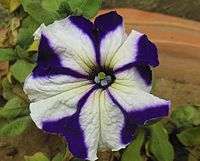 A cultivated form
A cultivated form- Leaves of Petunia × atkinsiana
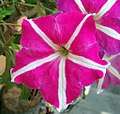 A cultivated form
A cultivated form
References
- ↑ "The plant list: Petunia". Royal Botanic Garden Kew and Missouri Botanic Garden. Retrieved 17 March 2018.
- ↑ "Complete Guide: How to Plant Petunias". J. Parker's. Retrieved 22 May 2018.
- ↑ "Petunia Flower: Its Meanings and Symbolism". Flower Meaning. Retrieved 22 May 2018.
- ↑ "Petunia Flower – Meaning, Symbolism and Colors". Flower Meanings. Retrieved 22 May 2018.
- ↑ “Classification for Kingdom Plantae Down to Family Solanaceae”. Natural Resources Conservation Service. United States Department of Agriculture. 2009. Web. July 8, 2009.
- 1 2 Ellis, Barbara W. Taylor's Guide to Annuals. Boston. Houghton Mifflin Co. 1999. Print.
- ↑ The Plant List: Petunia
- ↑ Ando, T, Kokubun, H., Marchesi, E., Suárez, E. & Basualdo, I. 2005. Phylogenetic Analysis of Petunia sensu Jussieu (Solanaceae) using Chloroplast DNA RFLP. Ann. Bot. 96(2): 289 - 297.
- ↑ Mishiba, Kei-Ichiro; Ando, Toshio; Mii, Masahiro; Watanabe, Hitoshi; Kokubun, Hisashi; Hashimoto, Goro; Marchesi, Eduardo (2000). "Nuclear DNA Content as an Index Character Discriminating Taxa in the Genus Petunia sensu Jussieu (Solanaceae)". Ann Bot. 85: 665–673.
- ↑ The Value of Growing Petchoa SuperCal®. Ornamental News Oct 25 2012
- ↑ Ando, T., Nomura, M. Tsukahara, J., Watanabe, H., Kokubun, H., Tsukamoto, T., Hashimoto, G., Marchesi, E., Kitching, I.(2001) Reproductive isolation in a native population of Petunia sensu Jussieu (Solanaceae) Ann. Bot. (Lond.) 88:403–413.
- ↑ Griesbach, R.J.(2007) in Flower breeding and genetics: Issues, challenges and opportunities for the 21st century, Petunia, ed Anderson N.O. (Springer, Dordrecht, The Netherlands), pp 301–336.
- ↑ Butterfly Conservation
- ↑ Johnson, ET; Berhow, MA; Dowd, PF. "Colored and white sectors from star-patterned petunia flowers display differential resistance to corn earworm and cabbage looper larvae". J Chem Ecol. 34: 757–65. doi:10.1007/s10886-008-9444-0. PMID 18484139.
- ↑ Brown, Deborah. “Growing Petunias” University of Minnesota Extension Office. University of Minnesota. 2009. Web. 25 June 2009. http://www.extension.umn.edu/distribution/horticulture/DG1120.html
- ↑ Allan M. Armitage, Armitage's Manual of Annuals, Biennials, and Half-Hardy Perennials (Portland: Timber Press, 2001).
- ↑ The Plant List, retrieved 13 September 2015
External links
| Wikispecies has information related to Petunia |
| Wikimedia Commons has media related to Petunia. |
- The Petunia Platform - a platform for Petunia-related research